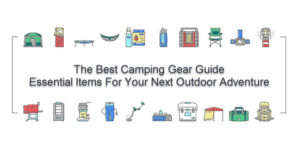Camping is a fun and exciting way to disconnect from technology, breathe fresh air, and enjoy nature. However, one of the most important aspects of camping that often gets overlooked is cooking. Without proper cooking equipment, you may find yourself struggling to prepare meals while on your trip. In this article, we will discuss how to choose the best camping cookware for your needs.
Introduction to Camping Cookware
When it comes to camping cookware, there are several types available in various materials and sizes. The type of cookware you choose depends on your personal preferences, budget, and the length of your trip. Some common types of camping cookware include pots, pans, skillets, griddles, Dutch ovens, and kettles. These items can be made from different materials such as aluminum, stainless steel, cast iron, or titanium. Each material has its advantages and drawbacks, so choosing the right one depends on your specific needs.
Types of Camping Cookware
Aluminum: Aluminum camping cookware is lightweight, durable, and affordable. It conducts heat well and is easy to clean. However, it can dent easily and isn’t suitable for use with high temperatures.
Stainless Steel: Stainless steel camping cookware is more expensive than aluminum but offers better durability and resistance to corrosion. It also provides even heating and is safe for use with high temperatures. On the downside, it can be heavier than other options and requires more maintenance.
Cast Iron: Cast iron camping cookware is heavy-duty and long-lasting. It retains heat well and distributes it evenly, making it ideal for baking bread or cookies. However, it requires seasoning before each use and can rust if not cared for properly.
Titanium: Titanium camping cookware is ultra-lightweight and strong. It doesn’t react with food, so it won’t alter flavors or cause allergic reactions. Additionally, it’s easy to clean and store. However, it can be pricey and fragile compared to other materials.
Materials Used in Camping Cookware
In addition to the different types of camping cookware, there are various materials used in their construction. Here are some of them:
Anodized Aluminum: Anodized aluminum is treated with an electrochemical process that makes it stronger and more resistant to scratches and corrosion. It’s lightweight, durable, and easy to maintain.
Non-stick Coating: Non-stick coatings make cooking and cleanup easier by preventing food from sticking to the surface. They’re usually made from PTFE (polytetrafluoroethylene) or ceramic.
Glass: Glass cookware is transparent, allowing you to see what’s inside without opening the lid. It’s also easy to clean and doesn’t absorb odors or flavors. However, it can break easily and isn’t suitable for use over open flames.
Features to Look for When Choosing Camping Cookware
When selecting camping cookware, consider these features:
Size: Choose the appropriate size based on the number of people you’ll be feeding and the type of dishes you plan to cook. A larger pot might be necessary if you want to boil water for multiple cups of coffee, whereas a smaller pan could work for frying eggs or sausages.
Weight: If you’re backpacking, opt for lighter weight cookware to reduce the load on your back. However, if you’re car camping, heavier pieces may be more comfortable to use.

Durability: Select camping cookware that’s built to last. Check reviews and look for products that have a reputation for being tough and reliable.
Heat Distribution: Even heat distribution ensures that food cooks evenly and quickly. Look for cookware with thick bottoms or bases that provide consistent heat.
Versatility: Consider versatile pieces that serve multiple purposes, like a skillet that doubles as a lid for a pot. This saves space and money in the long run.
Safety Features: Make sure your camping cookware has safety features like stay-cool handles, secure lids, and non-skid feet to prevent accidents.
How to Care for Your Camping Cookware
Proper care and maintenance of your camping cookware ensure that it lasts longer and performs optimally. Here are some tips:
Clean Immediately After Use: Clean your cookware immediately after using it to remove any food residue or debris. This prevents burned-on messes and makes cleanup easier.
Hand Wash Only: Don’t put your camping cookware in the dishwasher unless specified by the manufacturer. Hand washing ensures that they don’t get damaged or warped.
Air Dry: After washing, let your cookware air dry completely before storing it away. Moisture left behind can lead to rust or corrosion.
Store Properly: Keep your camping cookware organized and stored properly when not in use. This helps prevent damage and extends their lifespan.
Conclusion
Choosing the best camping cookware involves considering your individual needs, budget, and the duration of your trip. By understanding the different types of camping cookware, materials used, and features to look for, you can select the perfect set for your next adventure. Remember to take good care of your camping cookware by cleaning and storing it correctly to maximize its longevity. Happy camping!


